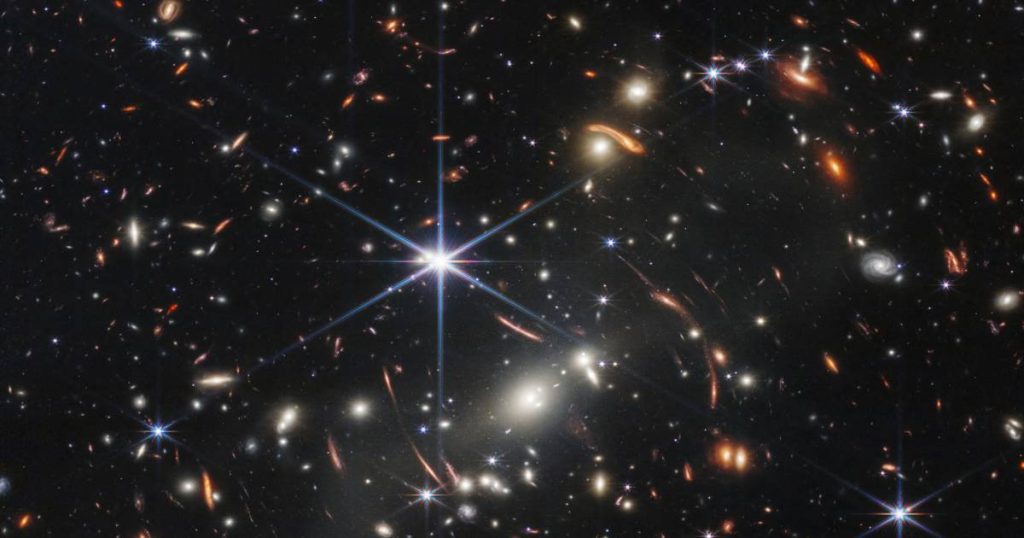The first image of the new James Webb Space Telescope (JWST) has been released. US President Joe Biden shared the first color image of thousands of galaxies that are billions of years old on Monday evening at approximately 11 p.m. GMT. “The James Webb Telescope will teach us a lot about the universe, for example about what happened next .the great explosion “It happened,” says science expert Martin Peters in the HLN LIVE studio.
Yorick Dupont and Elsie Brooksteig
Last updated:
11:01
source:
NASA, National Energy Agency, Reuters, Edge, Big Thing, Science Alert
JWST was sent into space on Christmas Day 2021 and then traveled 1.5 million kilometers. The telescope was able to capture this image after an extensive process of fine tuning and composition. For example, the distinctive golden mirrors of a space telescope had to be opened and positioned at the right angle, piece by piece. The devices have also been cooled, with one of them reaching minus 266 degrees Celsius.
“A new look at our world”
As the first test, James Webb was targeting a patch of sky called SMACS 0723. “Now we look at a part of the sky that looks the size of a grain of sand, and suddenly we see thousands of galaxies appearing in it,” Peters says on HLN LIVE.
It was US President Joe Biden and Vice President Kamala Harris who unveiled this first image from the Webb Telescope at a press conference. Biden called the telescope’s image and work “a new view of our universe.”
Galaxies like never before
SMACS 0723 contains galaxies so massive that they bend light. As a result, objects far from us can be seen. SMACS 0723 can be seen from the southern hemisphere of our planet (and therefore not from Belgium) in the constellation Flying Fish or Volans.
Many of the thousands of galaxies shown in the image were first captured by JWST. In some cases, this is the weakest infrared we’ve ever observed. The image is a composite of several images taken by JWST at different wavelengths. The result was a grayscale composite, which was colored using filters.
‘Big influence in science’
Having JWST successfully launched and set up without too many problems is a miracle in itself. What we can observe now thanks to a space telescope will provide a lot of new knowledge. “All the scientific data will be released soon and researchers will be wild. They will use it to see what’s going on there, how certain stars form, and what happened after the Big Bang. A great deal of research will be done on this data,” Peters says.
JWST can also perceive light that is almost as old as the universe itself. “We couldn’t observe this with the Hubble telescope, but we can with the special instruments of the James Webb Telescope,” Peters says.
In addition, we will be able to watch the birth of stars, as well as watch planets around stars other than our sun. That could help in the search for life elsewhere, says our science expert: “We’ll also be able to see if planets have habitable atmospheres and if there are the building blocks of life.”
The successor to the Hubble Space Telescope
JWST is a hundred times more sensitive than the famous Hubble Space Telescope, which is nearing its end. James Webb can detect light that is more than a billion years old than what Hubble can pick up. There are also many things that look like a single object in the images from Hubble.
To create this first image, the Webb Telescope collected light of different wavelengths for 12.5 hours. The Hubble Telescope took weeks to capture images of the galaxy cluster SMACS 0723.
James Webb has eighteen hexagonal mirrors that sit together, but can move independently of each other to focus. The mirror is made of beryllium, with a small 100-nanometer-thick layer of gold on top. This is a thousand times thinner than a human hair or paper. Beryllium is a light, strong base metal that can withstand extreme cold. Gold ensures that the mirror can better see infrared light.
The US-European-Canadian project will cost approximately 8 billion euros. James Webb can remain in business for up to 20 years. Tuesday afternoon at 4.30pm JWST photos will be posted.
See also: What makes the James Webb Telescope so pioneering? Our science expert explains.
Unlimited free access to Showbytes? And that can!
Sign in or create an account and never miss a thing from the stars.

“Total coffee specialist. Hardcore reader. Incurable music scholar. Web guru. Freelance troublemaker. Problem solver. Travel trailblazer.”








More Stories
GALA lacks a chapter on e-health
Weird beer can taste really good.
Planets contain much more water than previously thought